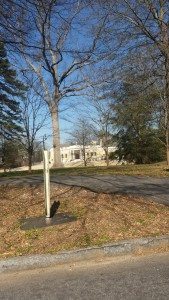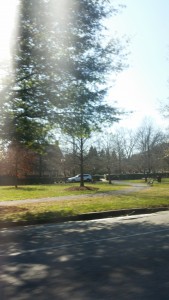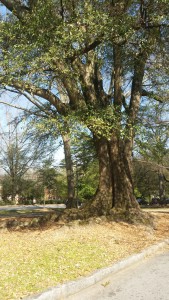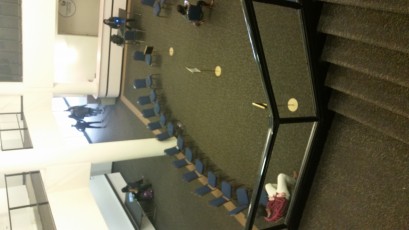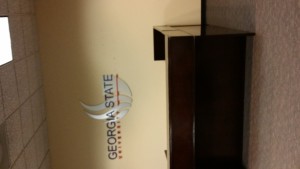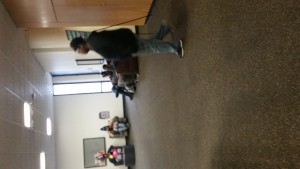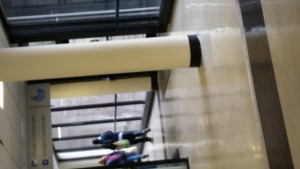Olmsted Linear Park #2
Olmsted Linear Park – AKA Long Park
The Olmsted Linear park is just as the name hints at, a very long linear park made of a few sectors. It is North of Atlanta in a very nice and clean neighborhood. Near the park is a church and a neighborhood.
From everything that I see and have heard about the park the park is over 100 years old.
The park is made mostly of organic items such trees and grass and the only inorganic or human items there were park benches and sidewalks. The side walks made the whole site very easy to navigate, and the site as a whole was very open and inviting. The most of the trees and grass were affected by the winter and had turned brown or lost their leaves. During the winter the site felt very sad and somber but as warm and inviting. The park presents itself as a very long park, which is great for paying or going for a walk. During my time at the park I saw many people who lived around there playing with their kids at the park. Seeing this park bringing families together to play games made me happy but also sad because I regretted not bring of own family there while I visited.
After going there and spending an hour there I can say that I’d love to go there again during the summer when all the trees are full of leaves and the grass is green. I look forward to see how the park can change in different seasons, and to see if the park feels warmer and even more inviting for family then.
Olmsted Linear park #1
Annotated Bibliography 3
Mehta, Chirag. Theodore, Nik. “WORKPLACE SAFETY IN ATLANTA’s CONSTRUCTION INDUSTRY: INSTITUTIONAL FAILURE IN TEMPORARY STAFFING ARRANGEMENTS.” WorkingUSA. Spring2006. 9.1(2006): 59. Business Source Complete. Web. 5 Feb 2016.
Both the writer of this article work with constructing buildings, the article talks about the issues in safety during building and how hazardous building builds and communities can be. The article has many diagrams and graphs that it uses to show that these companies will cut corner and use loops in things to avoid spending extra money on safety items. The article has many surveys they did to prove their facts. This article will help me by showing me how neighborhoods are formed and how sometimes buildings are not build right due to company negligence, which in turn leads them to being cheaper and creating more dangerous neighborhood and crime. This article is wrote by experts in the construction field who used many surveys to prove their facts, which means that everything in this survey is trustworthy and factual.
Annotated Bibliography 2
Oakley, Deirdre. Ruel, Erin. Reid, Lesley. “Atlanta’s Last Demolitions and Relocations: The Relationship Between Neighborhood Characteristics and Resident Satisfaction.” Housing Studies. 28.2(2013): 205. Advanced Placement Source. Web. 5 Feb, 2016.
All three of the writers of this article are Sociology professors, the article talks about how moving a community out of a lower income area to better neighborhoods will increase their happiness, helpfulness to society, and their ability to make money and have a job. The people who were moved were moved to safer areas, which allowed them to live longer and live happier. This change caused a drop in crime rate for that area and in turn for the whole city as well. The authors wrote this to inform people on how changes in a person environment can change a person’s whole attitude. This article will help in my study of crime and how to stop crime in low income areas around Atlanta. This article was wrote by professors who are experts on human interaction in societies and communities.
Annotated Bibliography 1
Ohmer, Mary L., Warner, Barbara D. Beck Elizabeth.”Preventing Violence in Low-Income Communities: Facilitating Residents’ Ability to Intervene in Neighborhood Problems.”Journal of Sociology & Social Welfare. 37.2 (2009): 162. Advanced Placement Source. Web. 5 Feb. 2016.
This article was written by two Social Work professors and one Criminal Justice professor, the article talks about crime and crime prevention in low income areas. The article start with talking about how something in the past have proven to bring down crime and make things safer, but it also addresses the problems of how somethings that helped another neighborhood may not be able to help another. The authors wrote this to help in identifying problems in a community and to help stop them, for people who protect neighborhoods and for neighborhoods to protect themselves. This article will help in my research of violence in poor areas and how poor or low income deal with the problems in their society. This article is an Academic Journal wrote by people who are experts in their fields who have done many studies on the subjects of criminal justice in more poor areas.
Urban life – business of the entry to Urban life From Student Center
Tapestry of Space
Margaret Morton’s pictures of the homeless in New York show how urban spaces can impact behavior. The first book, The Tunnel, was published in 1995 and the second book, Fragile Dwelling, was published in 2000. These two books pair photographs and stories of the homeless and their use of discarded items to make themselves a place to live. “The underground and above ground homes are designed by taking material fragments and lining up the pieces in a cohesive manner that corresponds to the splintered identity’s attempt to conform to the notion of a unified and solid self.”, this use of space to represent one’s self show how, like a home owner, they’re tied to the spaces where they live. A person’s house is a reflection of their personality and identity. These homeless people are not truly homeless, it would be more accurate to say they lack the presents of a stable home.
To understand Morton you need to apply twentieth century Marxist ideas about society. The term “spectacle” is used to show how society is depend on the use of media and images, and a society like this the individual understands themselves by the means of mass media. The society is shown something and then they want to gain that object or status. The people have been turned into a society that is controlled by whatever is shown to them, and the people themselves can no longer experience reality. The people had become controlled by the system and turned into whatever the leaders wanted, slowly making the people who lived there struggle more.
Many of Morton’s interviewed stayed in the tunnels, but some left to again see the outside world. Many of the ways into the tunnels had been blocked off or sealed to stop people from living there. Many of the homeless had been told they were trespassing and would need to leave and would be arrested, but they had no where else to go, so they stayed. The homeless has committed a criminal offence by being homeless and having no where to go. This pushing people out of the public spaces of the tunnels is just another way of controlling the public spaces.
The people of the tunnel have homes, which they built. The ideal that these people don’t have homes because they don’t own where they lived can be dismissed when you realized that many people don’t own the houses they live in. The difference between the homeless and those who have homes is different levels of vulnerability. People who are homeless know how vulnerable they are, but people who do have homes hide how vulnerable they are by blinding themselves with material things. The homeless struggle to find places in busy cities that are not being utilized by the cities population. To gives these people the right to house would give the right to house and the ability to removes these damaging stereotypes that depict them as lazy. There survival isn’t based on their ability to beg, but it is based on their ability to garden take care of animals, because they end up being more thoughtful and caring the land around them and the space they live.
Architectural Exclusion
Wealthy, mostly white residents of more Northern Atlanta have spoke out and opposed the expansion of the MARTA to keep poorer people and minorities out of their neighborhoods and jobs. In 1974 the city of Memphis closed a road connecting a mostly white neighborhood and a mostly bad neighborhood. The people in favor of this notion claimed it would help noise and safety. The notion was challenged, but any opposition to this notion was ignored. This action carried a strong message of discrimination, but that was some how not noticed by people who make sure things are not discriminatory.
This Article mainly focuses the discriminatory treatment of those who are exulted by how city are built more to cater to the rich and hide away the poorer citizens. The first part of this article focuses on how the built environment changes and shapes the behavior of those who live in them. This power to decide how people will act in area should give law-markers and people of power the ability to control everything, but they often ignore the impacts that some actions have on some areas.
All through history city builders and architects have used many different ways to keep people who are not wanted in an area out. Methods of law and violence are not looked highly upon when separating people, but the use of barriers such as walls and buildings is ignored and not looked down upon. We don’t really pay much attention to why things are built how they are or who they restrict. If you saw a bench with a bar in the middle you might thing it was made to have two arm rests, but sometimes things are cleverly hidden and what looked innocent is like that to keep the homeless from using it as a place to sleep. Sometimes things like this are done with some different idea that isn’t intended to restrict people, but end up doing it because of how something is designed.
The ability to control how a city is built can be good or bad. In the hands of somebody who is rich and wants to hide away minorities and the poor will you tactics like large buildings and walls around their neighborhoods to restrict their ability to move around and be seen. This is like a cafeteria who wants to promote healthy food choices by hiding and making it harder to reach junk food or poor health choices. This power to change how a city is laid out is a way of controlling people and regulating them.
Legal academics have come up with the notion that some places have racial meanings. “Elise C. Boddie argues that places have racial identities based on their history of or reputation for exclusion, and that courts should consider this racial meaning for purposes of racial discrimination claims.” These racial meaning let people like police officers keep tabs on minorities and keep some races and people away from things like parks. A leading land-use book has a chapter on tools of exclusion such as racially restrictive covenants and exclusionary zoning, but done not talk about exclusion based on features of the built environment.
